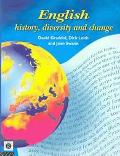

 |

|

The average rating for English History, Diveristy and Change based on 2 reviews is 3.5 stars.
Review # 1 was written on 2019-11-30 00:00:00 Anthony Thomson Anthony ThomsonIt's a textbook about the history of the English language, as such, it's not a thrill ride. However, it does include lots of maps and also many readings in various Englishes. The book emphasizes the variety of Englishes in the world. I was pleased that it was not a paean to the small island of England, and instead the book opens up many interesting topics without telling the reader what the answer may be. It is an older book, so instructors using it should supplement with more current readings. |
Review # 2 was written on 2016-07-14 00:00:00 Steven Pearlston Steven PearlstonAlso posted on Eva Lucias blog This source describes a historical period and how the English-speaking world expands rapidly. Various factors such as invasion and imperialism are strong influences on the process. The essay treats certain examples that can be considered as the most important, instead of making an attempt to cover all countries, colonies and places of interest. Instead of being only a single language, British English splits up into different varieties all over the world e.g. America (American English). Furthermore, the English language suddenly possesses the role of a second language. English transforms into a global language. The origin of the English-speaking world began with the Celtics in Northern England, who spoke “Brythonic” and “Geidelic” which today are the languages Modern Welsh and Gaelic, spoken in Ireland and Scotland. In the first century 63 BC, the Romans invaded Britain and declared Latin as the leading language, which remained a huge influence on the English language until the eighteenth century, mainly concerning education, laws and church, e.g. the first legal documents such as laws and deeds were written in Latin. In the fifth century 449 AD, the Anglo-Saxon invasion took place. Furthermore, the external evidence in the document; Gildas “On the Ruin and Conquest of Britain”1, written in 540s, gives a reliable image of the different invasions and how the people experienced it. This document shows how the Anglo-Saxon invasion is seen as a disaster from the Celtic point of view. The Anglo Saxon-routes formed the basis of the English language, which is known as the “Old English”. By analysing documents from the time, the so-called “internal evidence”, one will see the differences between “Old English”, “Middle English” and “Modern English”. An example shows the change from Old English to Modern English; “wæs” to “was”. The Anglo Saxon letters like “æ” changes and becomes more similar to the English one knows today with the use of the letter “a”. The Viking Invasion happened several times; both in 787 AD and 850 AD. The Vikings came from Scandinavia, mostly Denmark, who made settlements in the Northern and Eastern part of England, and Norway, who made settlements in the North-West and Scotland. Linguistic historian Kastovsky claims that: “the large number of adoptions into English of Scandinavian vocabulary and grammatical forms evidenced by texts of the thirteenth and fourteenth centuries suggests that by this time Scandinavian languages had been abandoned in favour of English” . Furthermore, the Old Norse (language of the Vikings) and Old English were related Germanic languages and that could have caused that they gradually became bilingual. However, there are still a few Old Norse words left in the Northern England, e.g. the word “Dale” (Yorkshire Dales) and “kirk” (Scots for “church”). The story of invasions carries on, when the Norman-French invaded in 1066 AD in the “Battle of Hastings”, and after that the following kings of England spoke French. During the Norman-French invasion, the English language adopted a lot of words that originally were French, e.g. “pork” (French) in comparison to “swine” (the Anglo-Saxon). Most of the adopted words reflected the dominance of the Normans, especially concerning the royal court and church. The language was based on verse and did not possess a consistent spelling, therefore made it very unstable for the speaker. In the later Middle Ages, several things changed concerning the “chosen” language (Latin), e.g. laws should be written in English and education material was translated into both English and French. An important decision concerning religion was made; The New Testament was translated into English in the 1380s, so therefore religion also became accessible for the “common man”, not only to the rich upper-class. In 1399, Henry IV spoke English as the first king since 1066. Bede’s “Ecclesiastical History of the English People”4, written in Latin in 731 AD, deals with the main focus of the conflict between the Romans and Celtic differences concerning Christianity. This document of external evidence has an important role in the development of the English National Identity, especially in the eighteenth century, where terms as “English” and “British” were established. An interesting source which allows the reader to learn more about the origin of the English language. Can only recommend it! Blog ~ Facebook ~ Instagram ~ Youtube ~ Spotify |
CAN'T FIND WHAT YOU'RE LOOKING FOR? CLICK HERE!!!